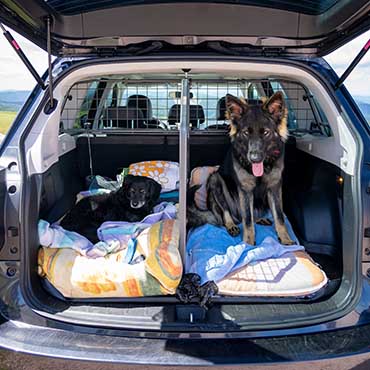Car sickness and motion sickness in dogs
Overview
- Car sickness is a common problem for puppies and dogs
- Travel training is the best way to prevent a car sickness problem developing
- Contact your vet if your dog suffers from car sickness, it’s best to intervene as soon as you notice a problem starting because if not managed correctly, it’s likely to get worse over time.
- Anti-sickness medication can be a good short-term solution, but the best long-term fix is to help your dog relearn about car travel so they stop being afraid and feeling sick.
What causes car sickness?
Car sickness/motion sickness is thought to be caused when certain types of movement affect the balance centre in the brain, combined with anxiety/stress when travelling. Car sickness is common in puppies but can also affect older dogs. Your dog is more likely to develop car sickness if they aren’t used to travelling or if they haven’t been slowly introduced to it as a puppy.

These dogs are safely secured in a car
Symptoms of travel sickness in dogs
Apart from vomiting, other signs of feeling nauseous/sick include:
- Drooling
- Panting
- Swallowing a lot
- Lip licking
- Retching.
Understandably, some dogs with car sickness become afraid of travelling, which often makes their symptoms worse and leads to problems even on short journeys. Signs your dog might be afraid of travelling include:
- Barking or whimpering
- Shaking before or during travel
- Peeing/pooing in the car
- Pulling away from the car or refusing to get inside.
Treating travel sickness
Once your dog has started suffering from motion sickness, it’s likely they’ll become nervous about getting in the car, and the problem will get worse if it’s not managed properly. Anti-sickness medication is sometimes a good short-term solution, but the best long-term solution is to help your dog relearn about car travel so they stop being afraid and feeling sick.
Restart travel training - stop travelling for a short time and start retraining your dog to give them good experiences in the car. Once they’re feeling happier, you can gradually start travelling again.
- Make sure your dog is confident with each of the steps below before moving to the next. Ideally, practice each step for 2-3 days. If your dog shows any signs of being anxious, stop the training, have a break and go back to the previous step. Reward your dog at each stage.
- Start by taking your dog to the car at times they don’t need to travel. Reward them with a treat or a toy for being near the car.
- Once your dog is happy to approach and stand next to the car, start encouraging them into it with all the doors open and the engine off.
- Once your dog is happy going inside the car, try closing the doors or putting the engine on, remember to reward them with a treat or toy.
- Next, get your dog used to their restraint. If your dog already has a restraint, you might want to try a new one (for example, switching from a harness to a crate or visa versa).
- Once your dog is relaxed inside the car with the engine on, try driving for one-two minutes but stop and walk home if they start to get worked up. Make sure your dog is happy on a few journeys before increasing the length.
- Build the journeys up a few minutes at a time from here, hopefully once your dog has had a few good experiences in the car, they’ll be happy to take longer journeys. Don’t forget to monitor them for any signs they’re feeling sick or anxious and take regular breaks.
Anti-anxiety products - there are a range of products available that can help your dog feel less anxious while they are travelling, these include pheromone collars, calming supplements and compression coats. Speak to your vet if you’re not sure which products to use.
Medications - there are licensed anti-sickness medicines that your vet can prescribe if your dog has very severe car sickness. Often these are used short term while you’re taking other steps to help your dog’s car sickness. Non-prescription and human medications for car sickness are often not effective and can have side effects.
Home remedies - herbal or natural products (often containing ginger or mint) are available, but unfortunately, there is no evidence to show they work.
Preventing car sickness
The best way to prevent car sickness is to gradually get your dog used to car travel. This is known as travel training.
- Start with short journeys (no more than five minutes), then gradually build up by a few minutes at a time
- Use a pet-safe crate or travel harness to help them feel safe and secure
- Give them something comfortable to sit on and make sure they don’t slip around when the car moves
- Take regular breaks on journeys.
Some other things that might help your dog when travelling:
- Feed them at least 2-3 hours before travel
- Walk them before a journey
- Keep them cool in the car (make sure the cool air reaches your dog in the back or the boot).
Published: July 2020
Did you find this page useful?
Tell us more
Please note, our vets and nurses are unable to respond to questions via this form. If you are concerned about your pet’s health, please contact your vet directly.
Thank you for your feedback
Want to hear more about PDSA and get pet care tips from our vet experts?
Sign up to our e-newsletter
Written by vets and vet nurses. This advice is for UK pets only. Illustrations by Samantha Elmhurst.

